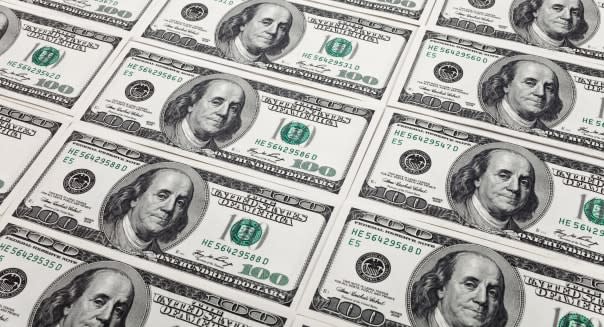Millions of New $100 Bills Defective? No, More Likely, It's Thousands

(UPDATE AND CORRECTION:)
Turns out, the folks over at the Bureau of Printing and Engraving didn't "mash" things up in the run-up to the launch of the new $100 bill nearly as badly as had originally been reported.
The original version of this article referred to a report indicating that the government would need to destroy $3 billion in defective hundred-dollar bills. We, and other media outlets, brought news of that report to our readers. But, after speaking with representatives from the BPE, it's clear that the screw-up is on a much smaller scale, and only a tiny percentage of the returned bills will need to be destroyed.
According to a Bureau spokesperson, the "mashing" issue affecting the bills is actually fairly common, appearing in about 0.1 percent of all printed bills. Usually those bills are flagged for removal before being delivered to the Federal Reserve, but in this case, the normal quality control process failed for reasons unknown. Upon discovering that the shipment contained some defective bills, the Fed returned the entire batch to the Bureau for re-inspection.
The Bureau expects that upon re-inspection, the returned shipment of 30 million bills will be found to have the usual defect rate of 0.1 percent, and those bills will be removed; the rest will be returned to the Fed. Thus, the total number of bills expected to be destroyed is far lower than initially reported: By our math, around 30,000 bills, or $3 million worth, will need to be replaced. The cost of destroying and replacing these bills is likewise expected to be far lower than reported.
There's no doubt that the Bureau of Printing and Engraving has been facing some serious issues: The redesign project is well behind schedule, and Bureau representatives still don't know what caused this latest screw-up. But it now appears that the magnitude of this is far lower than initially reported, and we apologize for the error. While the re-inspection process will take some time, the Bureau says it still expects to hit its goal of putting the new bills into circulation by the fall.
The original article is below.
Government to Destroy $3 Billion in Defective New $100 Bills
Conservatives like to accuse the government of throwing money away, but in this case, it's literally true.
The New Yorker reports that the government's much-delayed project to introduce a redesigned hundred-dollar bill has run into another setback: About 30 million of the bills -- that's $3 billion in cash -- were found to be defective, and will have to be destroyed and reprinted.
According to the report, the Federal Reserve returned the bills to the Bureau of Engraving and Printing upon finding them to be "clearly unacceptable." The offending bills showed signs of "mashing" -- essentially, the lines weren't crisp enough.
It's unclear how the Bureau managed to print 30 million defective bills without noticing anything was amiss, especially if they were "clearly unacceptable." But it's going to be a costly error. The Atlantic Wire calculates that reprinting the bills will cost about $3.8 million, based on the fact that the new bills cost about 12 cents each to print.
Sponsored Links
(Bit of currency trivia for you: It costs about as much to print a $100 bill as it does to mint a nickel.) While that's only about 0.1 percent of the value of the defective money, it's still an embarrassing blunder. The cost to shred the defective bills, at least, is trivial: Around $18,000, based on the Atlantic's back-of-the-envelope calculations, and adjusting for inflation.
The redesigned Benjamin -- which boasts a 3D strip to combat counterfeiters -- was originally supposed to come out back in February 2011. But this is the second time it's been significantly delayed by a printing error. As Wired explains, as much as $110 billion worth of hundred-dollar bills were affected by an earlier glitch that caused a the bills to crease as they went through the presses, resulting in blank slivers on the face of the bills.
The latest screw-up doesn't just require the government to reprint millions of bills -- the New Yorker reports that the Bureau of Engraving and Printing also needs to inspect billions of dollars' worth of additional bills to determine the extent of the problem. And the Fed says it won't accept new shipments of hundreds until the problem is definitely fixed. The Bureau is now in a race to hit its Oct. 8 deadline for delivering the new bills.
Matt Brownell is the consumer and retail reporter for DailyFinance. You can reach him at Matt.Brownell@teamaol.com, and follow him on Twitter at @Brownellorama.

